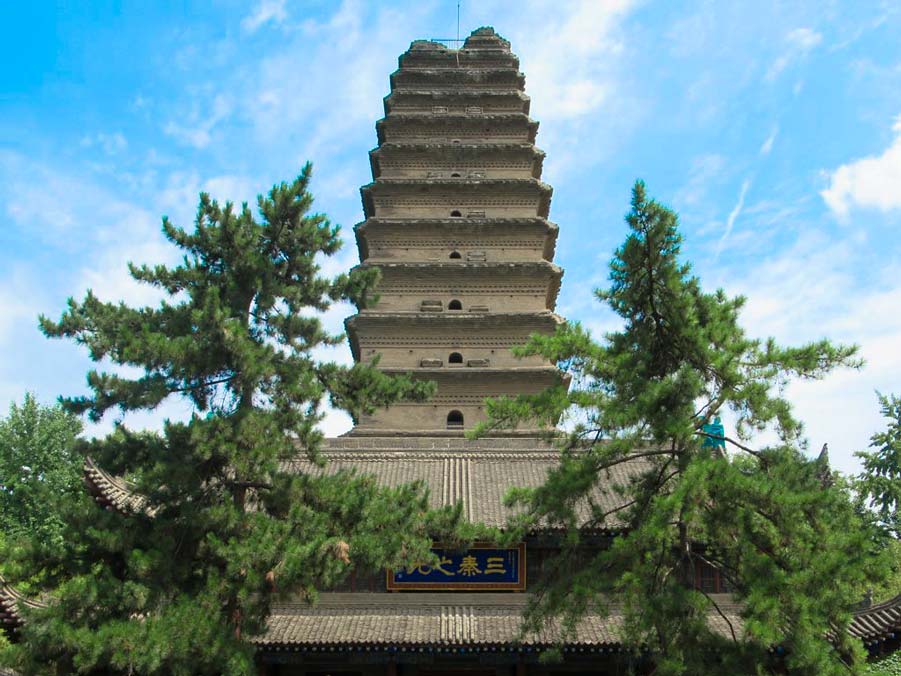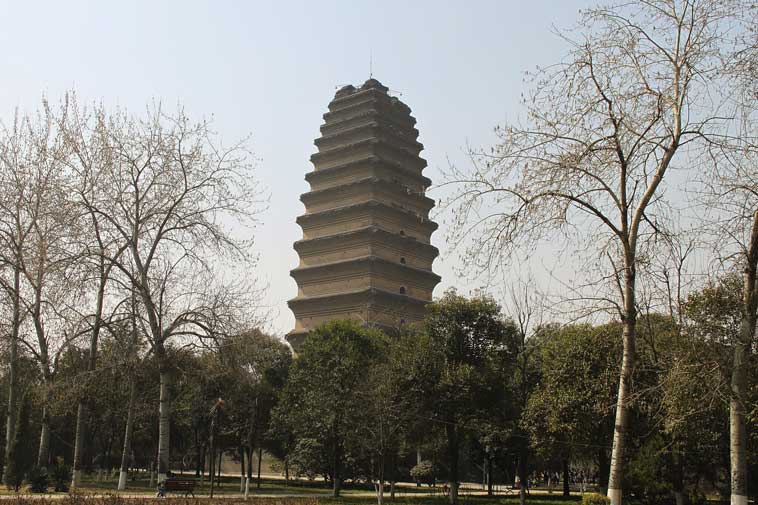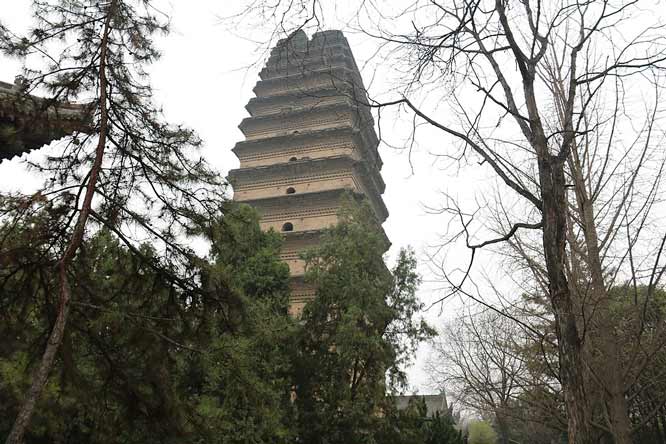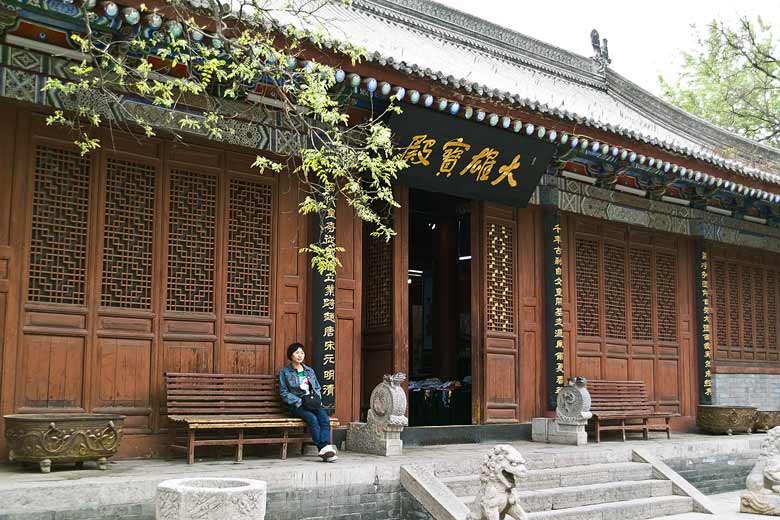


The Small Wild Goose Pagoda, an iconic landmark in China’s Shaanxi region that was designated as a UNESCO world heritage site in 2014, stands as a testament to the rich cultural heritage and spiritual significance of the ancient world. Pagodas hold profound spiritual symbolism and often served as places of worship, fostering a deep connection between humanity and the divine. Today we’ll unravel its historical mysteries and delve into the cultural tapestry that shaped this remarkable monument into what it is today. So, let’s dive in!
The Small Wild Goose Pagoda is located in the city of Xi’an, the capital of Shaanxi province in China. Nestled within the grounds of the Jianfu Temple, the pagoda stands as a serene oasis amid the bustling urban landscape of Xi’an. The city’s ancient name, Chang’an, holds great historical significance as the capital of multiple dynasties, including the illustrious Tang Dynasty.
With its strategic location on the Silk Road, Xi’an became a vibrant melting pot of diverse cultures, commerce, and spirituality. As a center of learning and religious activity, the city attracted scholars, merchants, and pilgrims from far-flung lands, fostering a unique cultural exchange that enriched the region.
The Small Wild Goose Pagoda’s setting in Xi’an offers visitors a unique opportunity to delve into China’s illustrious past, immersing themselves in the glorious history and spiritual heritage that once thrived in this ancient capital.

The Small Wild Goose Pagoda was built during the Tang Dynasty, specifically between 707 AD and 709 AD, making it over 1,300 years old.
This era marked a golden age in Chinese history, characterized by cultural and intellectual advancements. Emperor Zhongzong of the Tang Dynasty commissioned the pagoda’s construction as an expression of gratitude to the eminent monk Yijing, who had embarked on a perilous journey to India to obtain sacred Buddhist scriptures and relics.
The pagoda was originally constructed to house Buddhist scriptures and relics brought from India by the renowned monk Yijing. Yijing’s remarkable pilgrimage to India inspired the construction of this pagoda as a repository of his sacred treasures. The purpose of the pagoda was to preserve and promote the teachings of Buddhism, which had a profound influence on Chinese culture and spirituality.
The Small Wild Goose Pagoda originally stood at an impressive height of approximately 45 meters (147.6 feet), with fifteen levels but unfortunately in 1556, there was a massive earthquake that knocked down the upper levels of the pagoda and brought it to its current height of 43.4 meters (142.4 feet) and 13 levels.
So, to answer the question exactly, the Small Wild Goose Pagoda currently stands at a height of approximately 43.4 meters (142.4 feet).

The Small Wild Goose Pagoda earned its name due to its location of around 5km next to the “Giant Wild Goose Pagoda.” The “Giant Wild Goose Pagoda” used to be known as just the “Wild Goose Pagoda” but when the “Small Wild Goose Pagoda” was built, they decided to call it that due to it being slightly smaller than the already standing pagoda.
Don’t let the name fool you though, as the Small Wild Goose Pagoda is an absolute treasure in its own right and holds significant historical and cultural value in the history of Xi’an and Buddhism in China.
The pagoda hasn’t gone by many different names over the years and is simply known as the Small Wild Goose Pagoda. That being said one of its alternate names is simply the “Little Wild Goose Pagoda”. These two names are very similar and are often used interchangeably depending on who you talk to about the pagoda.

As we previously mentioned the Small Wild Goose Pagoda is located in this temple so before we proceed, let’s take a moment to appreciate the significance of the Jianfu Temple!
The temple served as a monastic residence, providing a tranquil retreat for monks to delve into their studies and spiritual practice. As a center of learning and religious activity, the Jianfu Temple attracted scholars, artists, and poets who sought inspiration amidst the spiritual aura that was emitted from the grounds.
The serene courtyards and intricate architectural details showcased the esteemed craftsmanship of the Tang Dynasty, reflecting the grace and elegance that characterized this golden age in Chinese history.
Over the centuries, the Jianfu Temple witnessed various renovations and reconstructions, preserving its cultural legacy and spiritual significance. Today, the temple complex continues to stand as an enchanting backdrop to the Small Wild Goose Pagoda, allowing visitors to immerse themselves in the vibrant spiritual culture of ancient China and explore the rich historical tapestry of this iconic site.

The Small Wild Goose Pagoda holds immense cultural significance and a profound legacy that resonates through the ages. It stands as a symbol of the historical and spiritual ties between China and India, as well as the spreading of Buddhist teachings.
Beyond its religious symbolism, the pagoda served as a source of inspiration for countless artists, poets, and writers throughout history. Its iconic silhouette has been depicted in various art forms, including paintings, calligraphy, and literature.
The pagoda’s serene presence against the backdrop of Xi’an’s bustling cityscape serves as a reminder of China’s rich heritage and the enduring power of human creativity. Designated as a UNESCO World Heritage Site in 2014, the Small Wild Goose Pagoda stands as a testament to the value of preserving cultural landmarks for future generations, safeguarding its architectural brilliance and spiritual legacy.
In conclusion, the Small Wild Goose Pagoda stands as a majestic time capsule, transporting us to the splendour of China’s ancient Tang Dynasty. It’s graceful silhouette and intricate carvings serve as a testament to the artistry and architectural brilliance of that golden era.
The Small Wild Goose Pagoda’s significance goes beyond its religious importance; it embodies the historical and cultural ties between China and India, fostering a profound legacy that transcends borders and time. It has inspired generations of artists, writers, and poets, leaving an indelible mark on Chinese art and literature. Its recognition as a UNESCO World Heritage Site ensures that its cultural heritage remains intact, allowing future generations to marvel at its grandeur and appreciate its enduring impact!

Image attribution for the cover image used in this article.
Related Articles:
Xi’an FAQs: Exploring China’s Ancient Capital City!
Exploring the 6 UNESCO World Heritage Sites in Xi’an!
Giant Wild Goose Pagoda FAQs: Exploring this iconic pagoda!
Xingjiao Temple Pagoda: Exploring a Symbol of the Silk Road!
What is a Pagoda? Exploring these Iconic Asian Towers!
China’s UNESCO World Heritage Sites: A Complete A-Z List!
UNESCO World Heritage Sites: The Ultimate Guide!